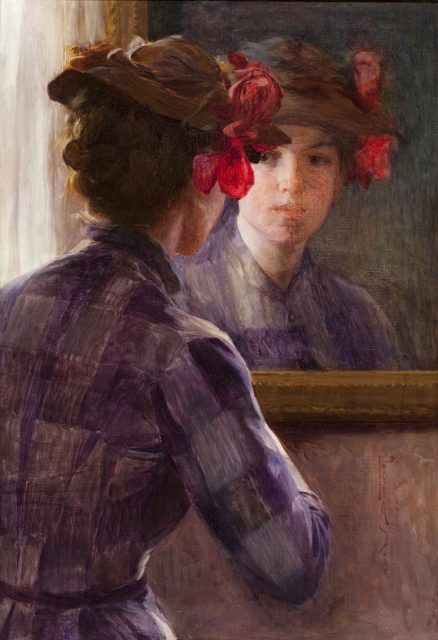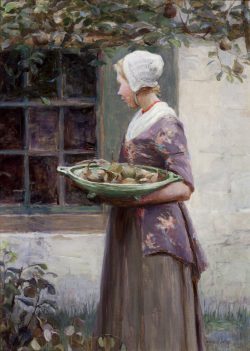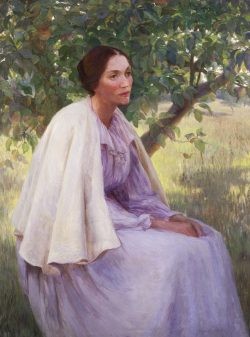- Categories
- Figural works
- Women
- Women artists
- Zoom in on Artwork
- Print Page
- Email Page to Friend
A young woman, her face visible only in a mirror, gazes meditatively at her reflection in Pauline Dohn’s A Village Belle. The title hints at the vanity of the subject’s self-scrutiny, perhaps prompted by the modest hat with its rakish adornment of red flowers. It also suggests nostalgia for a simpler, rural past—one evoked by the woman’s dress with its purple plaid pattern, which a reviewer described as “old timey.”i Blocked from view by her arm, the woman’s right hand may be lifted to adjust her hat as she tries different effects. The subtle manipulation of natural light, which highlights her mirrored face while leaving her body in shadow, adds to the viewer’s sense of having intruded on a private moment. Dohn evidently thought A Village Belle aptly demonstrated her talents, for after exhibiting it in the Art Institute of Chicago’s 1899 annual exhibition for Chicago artists, she sent it on tour with the Society of Western Artists, followed by a showing in the Carnegie International exhibition of 1900. That year, the painting was reproduced as the frontispiece of the January issue of the Chicago art journal Brush and Pencil.
A Village Belle appears to be a self-portrait, for the subject’s features resemble Dohn’s as recorded in photographs and a portrait line drawing of the artist made in the 1890s. For the painting Dohn selected a pose that avoided one of the most challenging technical problems inherent in self-portraiture: painting one’s own hands. The pose also focuses attention less on the woman’s manipulation of her physical appearance and more on her inner response. Dohn herself was no “village belle” but a native of Chicago, as well as a cosmopolitan artist at the pinnacle of her career. In A Village Belle, however, she reflects on her own complex identity and the process of seeing and being seen. Dohn gives an unusual narrative twist to a widely treated artistic conceit—a young woman contemplating her beauty in a mirror—by evoking a rural past that increasingly was regarded by many of her midwestern urban contemporaries with affectionate nostalgia. Formally and technically, meanwhile, the painting reflects Dohn’s sophistication, from its delicate painterly surface effects to the self-conscious aestheticism of the artist’s stylized vertical signature, a touch of fashionable japonisme.
Wendy Greenhouse, PhD
i “Art,” Chicago Times-Herald, Feb. 26, 1899.


